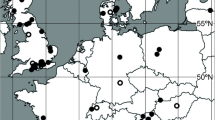Abstract
In a recent paper Amoruso et al. (2013) proposed a novel method for estimating population size of Feral Pigeons, the Superimposed Urban Strata (SUS) method. In our reply we firstly comment on the lack of a complete review of the available literature. Secondly we point out that the SUS method does not account for birds detection probability and thus it is just a simple index of abundance as many others proposed in recent years. Thirdly, we question the approach used by the authors to evaluate the reliability of their method. To conclude, we believe that the SUS method is not truly innovative and that further investigations are needed before considering it as a reliable way for estimating Feral Pigeons populations size.
Similar content being viewed by others
References
Amoruso I, Fabbris L, Mazza M, Caravello G (2013) Estimation of Feral Pigeon (Columba livia) population size using a novel Superimposed Urban Strata (SUS) method. Urban Ecosyst. doi:10.1007/s11252-013-0323-2
Buckland ST, Anderson DR, Burnham KP, Laake JL, Borchers DL, Thomas L (2001) Introduction to distance sampling: estimating abundance of biological populations. Oxford University Press, New York
Giunchi D, Baldaccini NE, Sbragia G, Soldatini C (2007a) On the use of pharmacological sterilisation to control feral pigeon populations. Wildl Res 34:306–318
Giunchi D, Gaggini V, Baldaccini NE (2007b) Distance sampling as an effective method for monitoring feral pigeon (Columba livia f. domestica) urban populations. Urban Ecosyst 10:397–412
Giunchi D, Albores-Barajas Y, Baldaccini NE, Vanni L, Soldatini C (2012) Feral pigeons: problems, dynamics and control methods. In: Soloneski S, Larramendy ML (eds) Integrated pest management and pest control - current and future tactics. InTech, Rijeka, pp 215–240
Haag D (1988) Die dichteabhängige regulation im brutschwarm der. Strassentaube Columba livia forma domestica. Ornithol Beob 85:209–224
Hetmański T (2004) Timing of breeding in the Feral Pigeon Columba livia f. domestica in Słupsk (NW Poland). Acta Ornithol 39:105–110
Hetmański T, Barkowska M (2007) Density and age of breeding pairs influence feral pigeon, Columba livia reproduction. Folia Zool 56:71–83
Hone J (1994) Analysis of vertebrate pest control. Cambridge University Press, Cambridge
Janiga M (1987) Seasonal aspects of intensity and course of daily translocations of pigeons (Columba livia f. domestica) for food from Bratislava to its surroundings. Acta Fac Rerum Nat Univ Comen Zool 32:47–58
Johnston RF (1984) Reproductive ecology of the feral pigeon, Columba livia. Occas Pap Mus Nat Hist Univ Kans 114:1–8
Johnston RF, Janiga M (1995) The feral pigeons. Oxford University Press, London
Lefebvre L (1985) Stability of flock composition in urban pigeons. Auk 102:886–888
Lefebvre L, Giraldeau LA (1984) Daily feeding site use of urban pigeons. Can J Zool 62:1425–1428
Murton RK, Thearle RJP, Thompson J (1972) Ecological studies of the feral pigeon Columba livia var. I. Population, breeding biology and methods of control. J Appl Ecol 9:835–874
Sacchi R, Gentilli A, Razzetti E, Barbieri F (2002) Effects of building features on density and flock distribution of feral pigeons Columba livia var. domestica in an urban environment. Can J Zool 80:48–54
Senar JC (1996) Bird census techniques for the urban habitat: a review. In: Controllo delle popolazioni ornitiche sinantropiche: problemi e prospettive. Istituto Superiore di Sanità, Roma, pp 36–44
Sutherland WJ (2006) Ecological census techniques. Cambridge University Press, Cambridge
Thompson WL (2002) Towards reliable bird surveys: accounting for individuals present but not detected. Auk 119:18–25
Author information
Authors and Affiliations
Corresponding author
Rights and permissions
About this article
Cite this article
Giunchi, D., Vanni, L., Soldatini, C. et al. Old and novel methods for estimating Feral Pigeons (Columba livia f. domestica) population size: a reply to Amoruso et al. (2013). Urban Ecosyst 17, 719–722 (2014). https://doi.org/10.1007/s11252-014-0344-5
Published:
Issue Date:
DOI: https://doi.org/10.1007/s11252-014-0344-5




